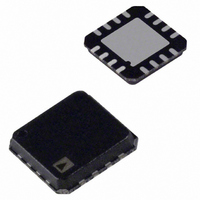AD8330ACPZ-R2 Analog Devices Inc, AD8330ACPZ-R2 Datasheet - Page 16

AD8330ACPZ-R2
Manufacturer Part Number
AD8330ACPZ-R2
Description
IC, VAR GAIN AMP, 150MHZ, 2DB, LFCSP-16
Manufacturer
Analog Devices Inc
Datasheet
1.AD8330-EVALZ.pdf
(32 pages)
Specifications of AD8330ACPZ-R2
No. Of Amplifiers
1
Bandwidth
150MHz
Gain Accuracy
2dB
Rail To Rail I/o Type
Rail Rail Outputs
No. Of Channels
1
Supply Voltage Range
2.7V To 6V
Amplifier Case Style
LFCSP
Amplifier Type
Variable Gain
Number Of Circuits
1
Output Type
Differential, Rail-to-Rail
Slew Rate
1500 V/µs
-3db Bandwidth
150MHz
Current - Input Bias
100nA
Current - Supply
20mA
Voltage - Supply, Single/dual (±)
2.7 V ~ 6 V
Operating Temperature
-40°C ~ 85°C
Mounting Type
Surface Mount
Package / Case
16-LFCSP
Rohs Compliant
Yes
Lead Free Status / RoHS Status
Lead free / RoHS Compliant
For Use With
AD8330-EVALZ - BOARD EVAL FOR AD8330
Current - Output / Channel
-
Gain Bandwidth Product
-
Voltage - Input Offset
-
Lead Free Status / RoHS Status
Lead free / RoHS Compliant, Lead free / RoHS Compliant
AD8330
The gain can be increased or decreased by changing the voltage,
V
of 500 mV is derived from the same band gap reference that
determines the decibel scaling. The tolerance on this voltage,
and mismatches in certain on-chip resistors, cause small gain
errors (see the Specifications section). Though not all appli-
cations of VGAs demand accurate gain calibration, it is a
valuable asset in many situations, for example, in reducing
design tolerances.
Figure 47 shows the core circuit in more detail. The range and
scaling of V
gain control pin, VDBS, presents a high incremental input re-
sistance (~100 MΩ) with a low bias current (~100 nA), making
the AD8330 easy to drive from a variety of gain control sources.
Inversion of the Gain Slope
The AD8330 supports many features that further extend the
versatility of this VGA in wide bandwidth gain control systems.
For example, the logic pin, MODE, allows the slope of the gain
function to be inverted, so that the basic gain starts at +50 dB
for a gain voltage, V
this voltage is at its maximum specified value of 1.5 V. The basic
forms of these two gain control modes are shown in Figure 48.
Gain Magnitude Control (V
In addition to the basic linear-in-dB control, two more gain
control features are provided. The voltage applied to Pin VMAG
provides accurate linear-in-magnitude gain control with a very
rapid response. The bandwidth of this interface is >100 MHz.
When this pin is unconnected, V
500 mV (see Figure 47) to set up the basic 0 dB to 50 dB range.
However, any voltage from ~15 mV to 5 V can be applied either
to lower the gain by up to 30 dB or to raise it by 20 dB. The
combined gain span is thus 100 dB, that is, the 50 dB basic gain
span provided by V
provided by V
G
MAG
BN
to generate a total gain, expressed here in magnitude terms.
G
, applied to the VMAG pin. The internally set default value
50
40
30
20
10
BN
0
0
=
DBS
10
Figure 48. Two Gain Directions of the AD8330
MAG
V
0
is independent of the supply voltage, and the
0.25
6 .
DBS
V
. The latter modifies the basic numerical gain
DBS
DBS
MODE PIN
LOW, GAIN
DECREASES
WITH V
, of zero and runs down to 0 dB when
plus a 60 dB linear-in-magnitude span
0.50
DBS
MAG
0.75
V
MAG
DBS
)
MODE PIN
HIGH, GAIN
INCREASES
WITH V
(V)
assumes its default value of
1.0
DBS
1.25
1.50
Rev. E | Page 16 of 32
(2)
Using this to calculate the output voltage,
from which it is apparent that the AD8330 implements a linear,
two-quadrant multiplier with a bipolar V
Because the AD8330 is a dc-coupled system, it can be used in
many applications where a wideband two-quadrant multiplier
function is required, from dc up to about 100 MHz from either
input (V
As V
point where this is limited by the absolute output limit imposed
by the supply voltage. In the absence of the latter effect, the
peak output into an open-circuited load is just
whereas for a load resistance of R
OPLO, it is
These capabilities are illustrated in Figure 49, where V
R
V
of V
supply-limited value when V
±5.65 V, that is, ±6 V − 0.35 V. Figure 50 demonstrates the high
speed multiplication capability. The signal input is a 100 MHz,
0.1 V sine wave, V
5 MHz alternating from 0.25 V to 1 V. The output is ideally a
sine wave switching in amplitude between 0.5 V and 2 V.
L
MAG
= O/C, V
MAG
V
V
MAG
V
G =
is set to 0.25 V, 0.5 V, 1 V, and 2 V. Except for the last value
OUT
OUT_PK
OUT
T
–2
–4
–6
–8
, the peak output follows Equation 5. This exceeds the
8
6
4
2
0
IN
is varied, so also is the peak output magnitude, up to a
–
= 2 × G
3
_
G
or V
PK
Figure 49. Effect of V
DBS
BN
= ±4 V
=
= 0 V, V
V
0
MAG
5 .
MAG
±
–
(
IN
2
R
2
DBS
).
V
MAG
× V
L
V
+
MAG
is set to 0.6 V, and V
IN
150
IN
is swept from −2.5 V dc to +2.5 V dc, and
–1
R
× V
)
L
MAG
MAG
MAG
V
on Gain and Peak Output
IN
= 2 V and the peak output is
L
0
( V)
directly across OPHI and
IN
1
MAG
and a unipolar V
is a square wave at
V
MAG
2
0.25V
= 2V
0.5V
1V
S
= 6 V,
3
MAG
(3)
(4)
(5)
(6)
.












